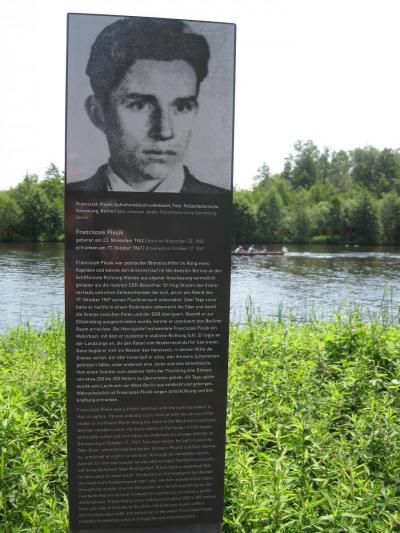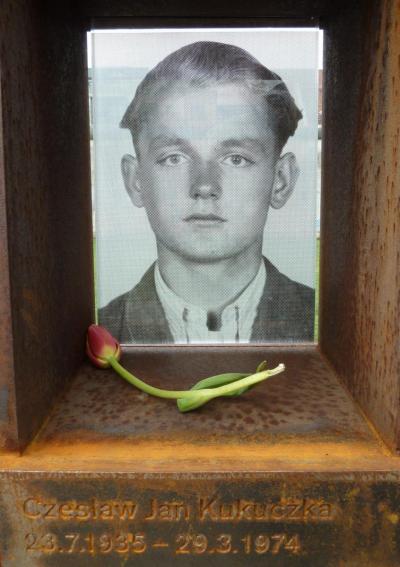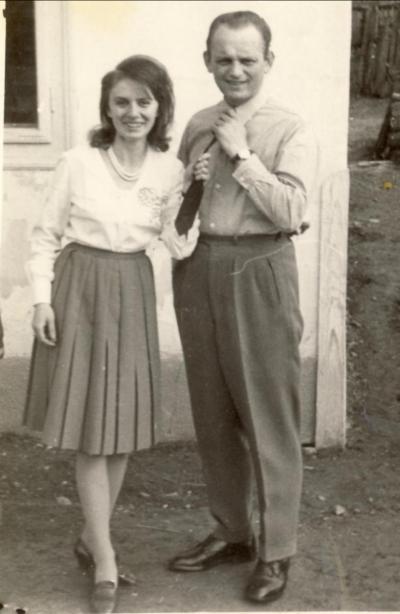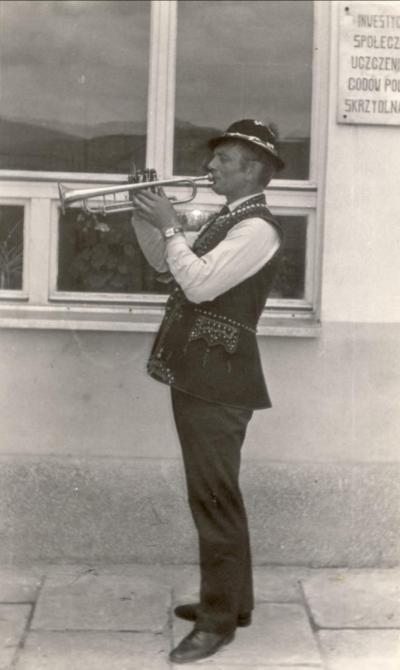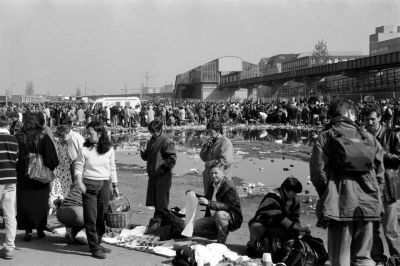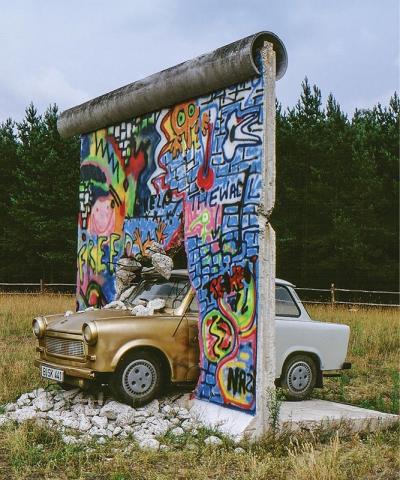Polish victims who died at the Berlin Wall: Franciszek Piesik and Czesław Kukuczka
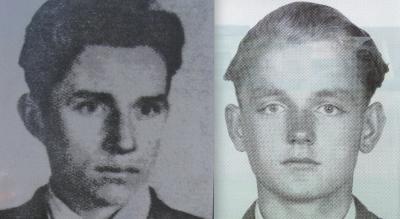
At least 139 people lost their lives trying to flee over the Berlin Wall. Two of them were Polish citizens, Franciszek Piesik and Czesław Kukuczka. That said, the list of victims is not yet binding. Historians are continually coming across further hitherto unknown cases of death and are attempting to reconstruct the incidents.
The Berlin Wall, the imposing symbol of the Cold War for 28 years, divided the city for 28 years. It was erected on 13th August 1961 and pulled down on 9th November 1989. Its history is directly linked to the division of Germany into four occupying zones after the Second World War: the Soviet, the American, the French and the British. The Allies had agreed to give the city of Berlin a special status and it was divided into four sectors. The western suburbs were administrated by France, the United States and Great Britain, whereas East Berlin was given to the Soviet Union.
The first travel restrictions between the zones of the divided country were introduced directly after the end of the war. As time went by they became ever more rigorous. Two of these were the introduction of the so-called Interzonenpasspflicht (Lit: Inter-Zone Pass Duty) and the erection of barbed wire, alarm systems and control posts along the border between the two German states. The growing tension between the Soviet Union and the Western powers led to a further sharpening of the exit regulations. Here the growing number of citizens living in East Germany who moved to the West now proved to be the most troubling problem for the East German (GDR) government. Estimates reckon that around 3,800,000 people left the country between the foundation of the GDR in 1949 and the building of the Wall, many of them by way of Berlin since the border there remained open for many years and it was particularly difficult to control travel between the East and West of the city.
In order to prevent the exodus of mostly young and well educated citizens the GDR government decided to build the Wall to separate the Soviet zone from the other zones in Berlin. The plans were kept secret. The extent of the wall and the vehemence with which it was built came as a complete surprise to the Allies. In the night of the 12th and 13th August 1961 the streets and railway lines which led to the Western part of Berlin were blocked off with barbed wire. In the following weeks this provisional measure was replaced by a 156 kilometre wall. The final division of the city had become a reality.
Even when the Berlin Wall made it almost impossible for the citizens of the GDR and other communist states to flee the city to the West, it was not enough to stop people making the attempt. Estimates say that, between 1961 and 1989, 5075 people succeeded in crossing the border illegally. But not everyone was so lucky. At least 139 people lost their lives trying to escape. Two of the victims of the Wall were Polish citizens.
On the night of 15th October 1967 Franciszek Piesik, a 24-year-old inland waterways captain, crossed the borders of the Oder between the Peoples Republic of Poland and the German Democratic Republic in a boat. Despite an immediate attempt to catch him the border guards were unsuccessful. Piesik reached the borders of Berlin.
Two days later, on the afternoon of 17th October, he reached the boarding stage at the “Betriebssportgemeinschaft Baumechanik” near Hennigsdorf, equipped with a wire cutter and a sketch map showing the course of the border along the water. Here he stole a motorboat. He subsequently travelled along the Havel canal to a lake (the Nieder-Neuendorfer See), where the border ran through the middle. To achieve this he was first compelled to make a diversion around the headland that separated the canal from the lake. The locals regarded this piece of land as an extremely dangerous marshy area. To this day it is still unknown why Franciszek Piesik succeeded in reaching the headland but did not round it by water, which he originally planned to do. He left his boat on the headland and walked to the banks of the lake where he abandoned his jacket, along with a briefcase containing his personal documents. From here he had to swim a distance of roughly 200 to 300 metres in water that was around 10 degrees cold. The report drawn up by the East German border guards says that he succeeded in crossing the border in the midst of the lake at around 18:15. That said, the border guards did not intervene, something that was held against them later when the incident was investigated internally.
Nonetheless Franciszek Piesik failed to reach his longed-for destination. 11 days later his body was taken from the Western part of the lake. The abduction excluded any possibility of a third party act. Piesik's airways were full of mud. Thus the most likely reason for his drowning was hypothermia. It took 2½ months for the Polish military mission to provide the West Berlin services with a personal description and fingerprints to confirm the identification of the dead man. Six months after the incident the body of Franciszek Piesik was buried in the cemetery at Berlin-Heiligensee. Piesik’s motives for fleeing to the West remain unclear. Today a pillar bears witness to the tragic events. It is situated at the “Berliner Mauerweg“, where the body of Piesik was found.
The case of the fireman Czesław Kukuczka, who was born in 1935 in Kamienica near Limanowa, was even more dramatic. No one knows how he got to Berlin and what happened until the 29th of March.
Around 12:30 a.m. on the same day Kukuczka entered the building of the Embassy of the Peoples Republic of Poland, which was then located at Unter den Linden. He told the doorman that he wanted to hand over an important document and was led to a room in the Embassy without any further checks. Here he was greeted by Colonel Maksymilian Karnowski, who worked in the Berlin operations group attached to the Polish Ministry of the Interior, along with a further colleague in the Embassy.
Kukuczka demanded that they provide him with a licence to travel to West Berlin before 15.00; otherwise he would blow up the Embassy and, with the aid of his accomplices, three other buildings including the Polish Information and Cultural Centre in East Berlin. Whilst he was making his demands he pointed to a tightly packed bag attached to his knees in which he claimed there was a self-made bomb. A loop resembling a fuse was hanging from the bag and during the conversation the man was nervously holding it the whole time. Kukuczka was able to convince the two men that he had learned how to build explosives during his military service.
Colonel Karnowski managed to leave the room by telling Kukuczka that he had to prepare his travel documents to West Berlin. But in reality Karnowski then telephoned a high-ranking representative of the GDR Ministry of State Security (Stasi) to inform him of the incident. A decision was made to take Kukuczka out of the building and “neutralise” him. Three Stasi representatives then entered the Embassy, leaving it once more at 14.40 with Kukuczka and a substitute passport and exit visa from the GDR. From here they took a Stasi car to the border at Friedrichsstraße.
What happened then is still unclear. Stasi documents say that Czesław Kukuczka was severely wounded by a shot in the back – the reasons were never investigated – around 15.00 without arousing the attention of other travellers at the border. He was subsequently taken to the Stasi penal hospital in the Berlin suburb of Hohenschönhausen, where he died on the operating table at around 18.30. When the Stasi officers opened the bag which contained the so-called bomb they found nothing more than personal belongings.
The incident attracted the attention of the press. On 2nd April the popular newspaper “Bild” published an article about the “assassins” at the Friedrichsstraße exit border. Following this the Stasi released the fingerprints of the dead man and in a further report now mentioned a weapon, with which they alleged that Kukuczka had threatened the guards at the border. This information was not mentioned in earlier documents. Suddenly the Stasi even “found” a pistol containing the fingerprints of the Pole who had been shot. But everything, including the abduction report from the coroner, points to the fact that Kukuczka was not carrying a weapon when he died. The Stasi agreed with the Polish authorities to burn the body in order to cover up any traces of the murder.
The urn with the mortal remains of Czesław Kukuczka only arrived at the home of his wife and three children at the end of May 1974. The burial ceremony took place at the cemetery in Kamienica near Limanowa, where the fireman grew up. Around the same time in East Berlin the Stasi officer Hans Sabath, who had accompanied Kukuczka to the border on 29th March, was awarded a medal, “For Services to the People and Fatherland”. The reason for this award was that he had succeeded in “preventing a provocation and neutralising a terrorist“.
It took until 2015 for the children of Czesław Kukuczka to discover what really happened to him on the 29th March 1974 when the German press investigated the case once more. Kukuczka’s wife had died a few years earlier without even knowing the truth. To this day no one knows why Czesław Kukuczka decided to try to flee to the West and why he decided to choose this way of doing so. The family suspects that he was motivated by financial problems.
Monika Stefanek, June 2017
The victims of the Berlin Wall are commemorated in the multimedia website Chronik-der-Mauer.de, which was set up in 2004 by the Federal Centre for Political Education, Deutschlandradio and the Centre of Contemporary History Research in Potsdam. Information on those who died along with a corresponding list of names is continually being updated.
Edit:
In August 2021, at the request of the Public Prosecutor of the Branch Office of the Commission for the Persecution of Crimes against the Polish People in Poznań (Oddziałowa Komisja Ścigania Zbrodni przeciwko Narodowi Polskiemu w Poznaniu), Poznań District Court (Sąd Okręgowy w Poznaniu) issued a European arrest warrant against the German citizen Manfred N. The former officer of the Ministry for State Security of the former GDR (Stasi) is alleged to have shot and fatally wounded Czesław Kukuczka at the Friedrichstraße border crossing on 29 March 1974.
The communiqué from the Commission for the Persecution of Crimes against the Polish people states:
“The investigations carried out by the Oddziałowa Komisja Ścigania Zbrodni przeciwko Narodowi Polskiemu w Poznaniu showed, without doubt, that the Ministry for State Security in the former GDR had set a trap for Czesław K. and had planned from the outset to prevent him from leaving East Berlin, even if this would cost him his life. The perpetrator fired the fatal shot insidiously and without warning into the victim’s back when he no longer posed a threat. He tacitly accepted his death. Czesław K., who was not carrying an explosive device, was killed in a cowardly manner, whereby, in asserting that he had had a firearm and had threatened the border soldiers with it, the East German authorities created a red herring designed to make their activities appear legitimate. Therefore, the action taken by the Stasi were aimed at preventing Czesław K. from crossing the border at any price whilst violating his basic human right in the name of the political objectives of a totalitarian state. In fact, this incident was an execution without trial.”[1]
This was the very first time that this type of order of summary punishment was issued against a foreign citizen suspected of having committed Communist crimes. However, there will be no prosecution of Hans Sabath, the former Head of the Chief of Staff of the Stasi and head of the campaign to “neutralise Kukuczka”. He died in 1986.
Monika Stefanek, August 2021
[1] Press release from the Główna Komisja Ścigania Zbrodni przeciwko Narodowi Polskiemu, Source: https://ipn.gov.pl/pl/dla-mediow/komunikaty/148081,Europejski-Nakaz-Aresztowania-wobec-obywatela-Niemiec-bylego-oficera-operacyjneg.html?fbclid=IwAR24tDqCpnfbxvV8Q-osuPHWlgmhA7fdlHVHhSmwtnx7t1cQYVFnCmKr8so (last accessed on 17/8/2021).
